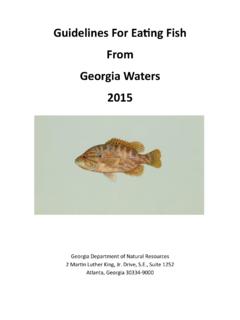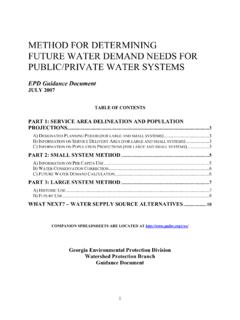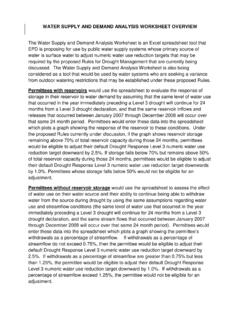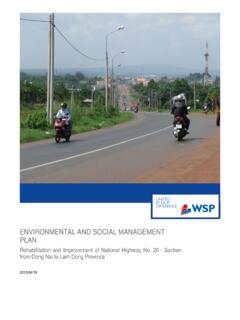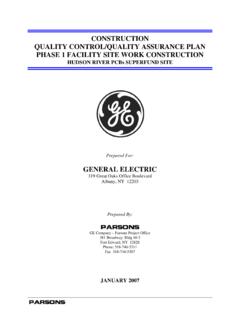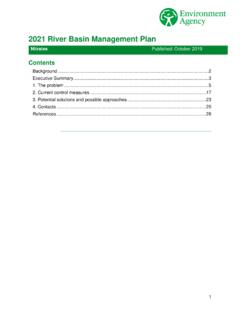Transcription of 391-3-7 05 Buffer Variance Procedures and Criteria
1 Buffer Variance Procedures and Criteria (1) Buffers on state waters are valuable in protecting and conserving land and water resources; therefore, buffers should be protected. The Buffer Variance process will apply to all projects legally eligible for variances and to all state waters having vegetation wrested from the channel by normal stream flow, provided that adequate erosion control measures are incorporated in the project plans and specifications and are implemented. The following activities do not require application to or approval from the Division: (a) stream crossings for water lines or stream crossing for sewer lines that occur at an angle, as measured from the point of crossing, within 25 degrees of perpendicular to the stream and cause a width of disturbance of not more than 50 feet within the Buffer ; or (b) where drainage structures must be constructed within the twenty-five (25) foot Buffer area of any state water not classified as a trout stream; or (c) where roadway drainage structures must be constructed within the twenty-five (25) foot Buffer area of any state waters or the fifty (50) foot Buffer of any trout stream; or (d) construction of bulkheads or sea walls on Lake Oconee and Lake Sinclair where required to prevent erosion at the shoreline.
2 Or (e) construction of public water system reservoirs. (2) Variance applications will be reviewed by the Director only where the applicant provides reasonable evidence that impacts to the Buffer have been avoided or minimized to the fullest extent practicable and only in the following cases: (a) The project involves the construction or repair of an existing infrastructure project or a structure that, by its nature, must be located within the Buffer . Such structures include, include but are not limited to, dams, public water supply intake structures, detention/retention ponds, waste water discharges, docks including access ways, boat launches including access ways, and stabilization of areas of public access to water; or (b) The project will result in the restoration or enhancement to improve water quality and/or aquatic habitat quality; or (c) Buffer intrusion is necessary to provide reasonable access to a property or properties; or (d) The intrusion is for gravity-flow sewer lines that cannot reasonably be placed outside the Buffer , and stream crossings and vegetative disturbance are minimized.
3 Or (e) Crossing for utility lines, including but not limited to gas, liquid, power, telephone, and other pipelines, provided that the number of crossings and the amount of vegetative disturbance are minimized; or (f) Recreational foot trails and viewing areas, providing that impacts to the Buffer are minimal; or (g) The project involves construction of one (1) single family home for residential use by the owner of the subject property and, at the time of adoption of this rule, there is no opportunity to develop the home under any reasonable design configuration unless a Buffer Variance is granted. Variances will be considered for such single family homes only if construction is initiated or local government approval is obtained prior to January 10, 2005; or (h) For non-trout waters, the proposed land disturbing activity within the Buffer will require a permit from the United States Army Corps of Engineers under Section 404 of the federal Water Pollution control Act Amendment of 1972, 33 Section 1344, and the Corps of Engineers has approved a mitigation plan to be implemented as a condition of such a permit; or (i) For non-trout waters, a plan is provided for Buffer intrusion that shows that, even with the proposed land disturbing activity within the Buffer , the completed project will result in maintained or improved water quality downstream of the project.
4 Or (j) For non-trout waters, the project with a proposed land disturbing activity within the Buffer is located in, or upstream and within ten linear miles of, a stream segment listed as impaired under Section 303(d) of the federal Water Pollution control Act Amendment of 1972, 33 Section 1313(d) and a plan is provided that shows that the completed project will result in maintained or improved water quality in such listed stream segment and that the project has no adverse impact relative to the pollutants of concern in such stream segment; or (k) The proposed land disturbing activity within the Buffer is not eligible for a permit from the United States Army Corps of Engineers under Section 404 of the federal Water Pollution control Act Amendment of 1972, 33 Section 1344, but includes required mitigation in accordance with current EPD Stream Buffer Variance Mitigation Guidance document, and involves: 1.
5 Piping, filling, or re-routing of non-trout waters that are not jurisdictional Waters of the ; or 2. stream Buffer impacts due to new infrastructure projects adjacent to state waters (jurisdictional and non-jurisdictional Waters of the ). This criterion shall not apply to maintenance and/or modification to existing infrastructure, which are covered under (2)(a). (3) If the Buffer impact will be minor, the Buffer Variance request shall include the following information at a minimum: (a) Site map that includes locations of all state waters, wetlands, floodplain boundaries and other natural features, as determined by field survey. (b) Description of the shape, size, topography, slope, soils, vegetation and other physical characteristics of the property. (c) Dated and numbered detailed site plan that shows the locations of all structures, impervious surfaces, and the boundaries of the area of soil disturbance, both inside and outside of the Buffer .
6 The exact area of the Buffer to be impacted shall be accurately and clearly indicated. (d) Description of the project, with details of the Buffer disturbance, including estimated length of time for the disturbance and justification for why the disturbance is necessary. (e) Calculation of the total area and length of the Buffer disturbance. (f) Letter from the issuing authority (if other than the Division and as applicable). stating that the issuing authority has visited the site and determined the presence of state waters that require a Buffer and that a stream Buffer Variance is required as per the local erosion and sedimentation control ordinance. (g) Erosion, sedimentation and pollution control plan . (h) Re-vegetation plan as described in the most recent publication of the Division's guidance book, Streambank and Shoreline Stabilization and/or a plan for permanent vegetation as per the Manual for Erosion and Sedimentation control in Georgia.
7 (i) For projects within the Buffer of or upstream and within one linear mile of impaired stream segments on Georgia's 305(b)/303(d) List Documents (Final), . documentation that the project will have no adverse impacts relative to the pollutants of concern and if applicable, documentation that the project will be in compliance with the TMDL Implementation plan (s). (j) Any other reasonable information related to the project that the Division deems necessary to effectively evaluate the Variance request. (k) Applications must be on the most current forms provided by the Division. (4) If the Buffer impact will be major, the Buffer Variance request shall include all of the information in Sections (3)(a) thru (k) above, with the exception of (3)(h). A Buffer Variance request for major Buffer impacts shall also include the following additional information: (a) For Variance requests made under Section (2)(h), a copy of the permit application and supporting documentation, as submitted to the United States Army Corps of Engineers under Section 404 of the federal Water Pollution control Act Amendment of 1972, 33 Section 1344.
8 (b) Buffer mitigation plan addressing impacts to critical Buffer functions, including water quality and floodplain, watershed and ecological functions based on an evaluation of existing Buffer conditions and predicted post construction Buffer conditions pursuant to Section (7)(c) herein. (c) plan for stormwater control once site stabilization is achieved, when required by a local stormwater ordinance. (d) For Variance requests made under Sections (2)(i) and (2)(j), the application shall include the following water quality information: 1. Documentation that post-development stormwater management systems to conform to the minimum standards for water quality, channel protection, overbank flood protection and extreme flood protection as established in the Georgia Stormwater Management Manual or the equivalent and if applicable, the Coastal Stormwater Supplement to the Georgia Stormwater Management Manual.
9 2. Documentation that existing water quality will be maintained or improved based on predicted pollutant loading under pre- and post-development conditions as estimated by models accepted by the Division. (e) For Variance requests made under Section (2)(j), if the proposed project is in, or upstream and within ten linear miles of impaired stream segments on Georgia's 305(b)/303(d) List Documents (Final), documentation that the project will have no adverse impacts relative to the pollutants of concern and if applicable, documentation that the project will be in compliance with the TMDL. Implementation plan (s). (f) For Variance requests made under Section (2)(k)1., the application shall include documentation from the United States Army Corps of Engineers verifying the water bodies identified in the application are non-jurisdictional waters of the United States under Section 404 of the Clean Water Act.
10 (5) Upon receipt of a completed application in accordance with Sections (3) or (4), the Division shall consider the completed application and the following factors in determining whether to issue a Variance : (a) Locations of state waters, wetlands, floodplain boundaries and other natural features as determined by field surveys. (b) Shape, size, topography, slope, soils, vegetation and other physical characteristics of the property. (c) Location and extent of Buffer intrusion. (d) Whether reasonable alternative project designs, such as the use of retaining walls, are possible which do not require Buffer intrusion or which require less Buffer intrusion. (e) Whether issuance of the Variance , with the required mitigation plan , re-vegetation plan and/or plan for permanent vegetation, is at least as protective of natural resources and the environment (including wildlife habitat).






